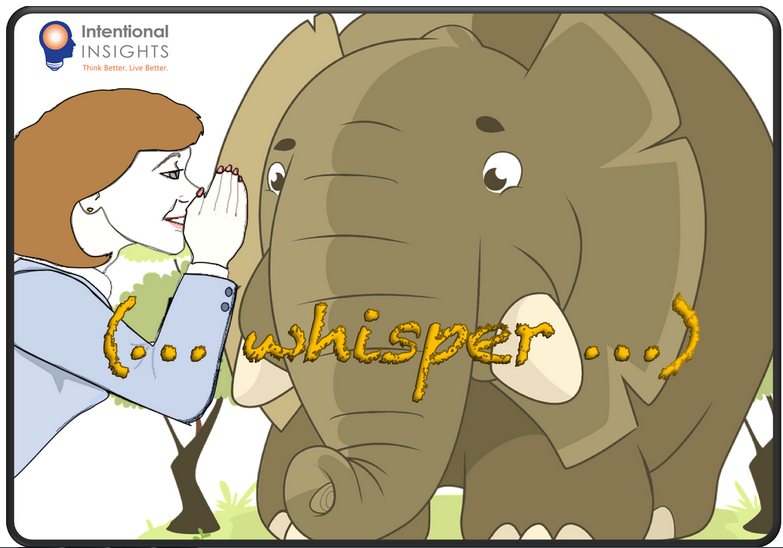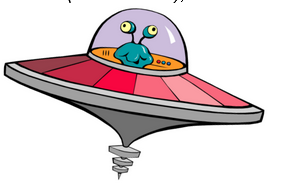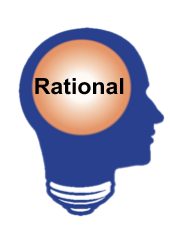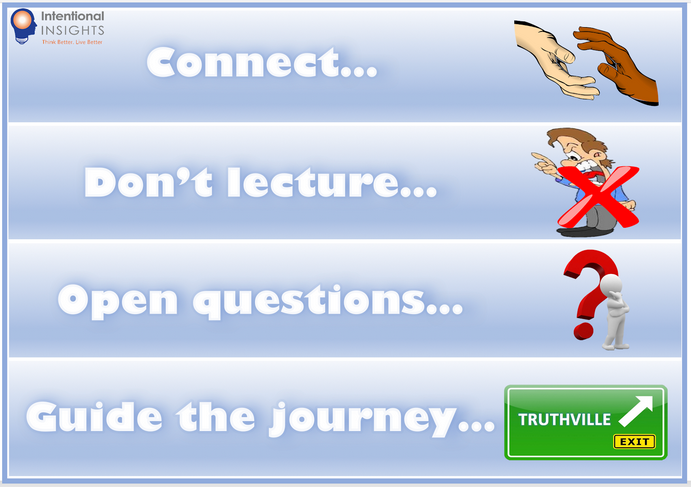
Many struggle in dealing with people who have become attached to political viewpoints that are irrational — based on poor logic or on “alternative facts.” This how-to guide helps you talk to such folks, whether they are sincerely mistaken or just deliberately aggravating — behavior known as trolling. The guide offers strategies informed by psychology and neuroscience research, while laying out these strategies in a visually engaging form. It is part of the bigger Rational Politics project at Intentional Insights that uses effective communication strategies to promote rational thinking, truth-telling, and wise decision-making in politics.
Whispering to the Elephant
You might be wondering about the elephant on the cover. First, what it’s not meant to be is the GOP mascot — it just ain’t, no way. It’s a non-partisan elephant—okay?

It’s actually a metaphor for the dual nature of human intelligence. Dr. Gleb Tsipursky, the Co-Founder of Intentional Insights, uses the term “autopilot system of thinking” to describe this more primitive part of our minds (see the Glossary of Terms at the end of the guide for more information). Emotive, intuitive, and reactive, it’s what allows us to quickly respond to a threat, whether it’s a venomous snake, a speeding truck, or a schoolyard bully. It’s also the part we use most often in our day-to-day lives. Although it’s an essential part of who we are, and we do need to value and respect it, the autopilot system is not particularly rational.
As you’ll see, in order to effectively connect with a true believer, you’re going to need to learn to speak softly to his or her Elephant, while guided by your Rider — which leads us to this meme:
Caption: Meme — Whispering to the Elephant, by W. Straight for Intentional Insights.
Images courtesy of Clipart Library, and pixabay.
But before we get to the true believers let’s discuss…
*****

Those Doggone Trolls!
Someone once asked me “How do you deal with political trolls?” Part of my response was to “Get them to state their values. If they’re unwilling or unable to do so, then end the discussion.”
That advice still stands. Dealing with a troll is simply not worth the time and energy it takes. “But” you ask “how will I know whether someone is a troll?”
Fair question. First of all your troll will most likely be a male between the ages of 16 and 30 — seems to go with the territory for some reason — so I’ll use masculine pronouns to refer to him. Secondly, trying to pin him down to a firm position will be like a game of Whack-a-Mole, with him dodging and weaving, leading you off on tangents and trying to make you look like a fool. That’s his game, and you can take it to the bank that’s what it is to him. He thinks it’s fun, whether he’s doing it for pay or not. The name of this game is domination, control, and humiliation to prove that he’s somehow better, bigger, smarter, meaner than you. He’s a digital vandal, a sadist, a bully. Don’t let him draw you in.
Here are some specific red flags to let you know you’re dealing with a troll:
- If he tries to reword your argument with a different slant.
- If he tries to make himself seem to be your superior in morality, patriotism, intellect.
- If he tries to change the focus of the argument, change the subject, make accusations, call you names, whatever it takes to distract you.
- If he tries to introduce non-sequiturs — subjects not related to the discussion.
- If he tries to take over the conversation and side-line you.
- If he tries to make you speechless with anger and outrage.
- If he tries to confuse you.
(J. Bauer’s The Mountain Troll, 1904,
Courtesy of Wikimedia Commons.)
If you insist on engaging with him once you know he’s a troll, there are a lot of good online articles on how to deal. Here’s a link to one of my favorites — there are additional useful urls listed in Addendum I.
The article cited above provides a classic example of how a troll does what he does. Taken from the movie Thank You For Smoking, the character Nick Naylor, a lobbyist for Big Tobacco, is telling his son Joey how he wins:
- Son: What happens when you’re wrong?
- Dad: Whoa, Joey I’m never wrong.
- Son: But you can’t always be right…
- Dad: Well, if it’s your job to be right, then you’re never wrong.
- Son: But what if you are wrong?
(Image courtesy of DBCLIPART)
- Dad: OK, let’s say that you’re defending chocolate, and I’m defending vanilla. Now if I were to say to you: ‘Vanilla is the best flavor ice-cream’, you’d say…
- Son: No, chocolate is.
- Dad: Exactly, but you can’t win that argument… so, I’ll ask you: so you think chocolate is the end-all and be-all of ice-cream, do you?
- Son: It’s the best ice-cream, I wouldn’t order any other.
- Dad: Oh! So it’s all chocolate for you is it?
- Son: Yes, chocolate is all I need.
- Dad: Well, I need more than chocolate, and for that matter I need more than vanilla. I believe that we need freedom. And choice when it comes to our ice-cream,and that Joey Naylor, that is the definition of liberty.
- Son: But that’s not what we’re talking about
- Dad: Ah! But that’s what I’m talking about.
- Son: …but you didn’t prove that vanilla was the best…
- Dad: I didn’t have to. I proved that you’re wrong, and if you’re wrong I’m right.
- Son: But you still didn’t convince me
- Dad: It’s that I’m not after you. I’m after them.
Do you see what Nick did there? He pulled an All-Lives-Matter style switcheroo, redirecting the entire focus of the debate. He won over the audience, and diminished his opponent in the eyes of that audience — even though he never once provided any evidence that “Vanilla is the best flavor ice-cream.”
So, what can you do to defend yourself?
- Know your stuff, do the research, have your ducks in a row.
- Stick to your guns — keep coming back to your original point.
- Don’t let him get you mad.
- If he wants to make a fool of himself by calling you names, let him — don’t take the bait.
- Disengage as soon you’re sure you’ve made your point.
- Most importantly, don’t put yourself down if you fail — he’s had a lot more practice at it than you have.
This info-graphic may help you keep these points in mind:

Caption: Infographic — Steps for Dealing with Trolls, by W. Straight, for Intentional Insights.
Troll image is from watercolor by John Bauer, 1915, courtesy of Wikimedia Commons.
*****
Belief Is a Powerful Thing
At the beginning of the previous section I shared my response to a question on dealing with political trolls. Here’s the rest of my response:
“Get them to state their values….If they do, then ask how they think … … and his policies impact their values. It’s really about getting them to analyze the value of … … for themselves — on a personal, physical, fiscal, emotional, religious, ethical, etc., basis. Making definitive statements on your opposition to … … will only put them on the defensive. Leading them to think you may be persuaded (or dissuaded) will open them up. But once they have extended themselves, then it’s your turn to ask them (not tell them), how such and such an action reflects a given personal value. It will take patience…”
 Yep, if that person is willing to share his or her values, no matter how woo-woo those values may be, it’s a pretty good bet that you’re dealing with a true believer — someone who, though mistaken, is sincere, and thus worth a conversation.
Yep, if that person is willing to share his or her values, no matter how woo-woo those values may be, it’s a pretty good bet that you’re dealing with a true believer — someone who, though mistaken, is sincere, and thus worth a conversation.
(Image courtesy of ClipArt Fest.)
So, they’ve expressed some far-out opinions and you’d like to show them where they’re wrong, right? Hold your horses, before you even think about getting them to change their minds, you’ve got to get on their wavelength. In other words, you’ve got to relate to them emotionally, not intellectually. You’ve got to reach their Elephant.
This is the most important part of the whole process!
The bottom line is that you want to connect with them at a gut level. To do so takes empathy, friendliness, discovering common threads between your lifestyle, history, upbringing, and theirs; and then using that as a bridge to an honest but well thought-out exchange of ideas and beliefs.
Remember that at the start, they won’t know you from Adam — you’ll just be a faceless username on their computer or cellphone. For all they know, you could even be a troll. Making progress will take patience and compassion.
Begin by expressing curiosity. Relate their responses to your own experiences, in terms of what you and they have in common. If they respond favorably, continue questioning. Avoid expressing any skepticism about their beliefs. Draw them out. Ideally, this will encourage them to be more open and expansive.
They won’t engage frankly with you until they feel they can trust you. They won’t trust you until they see you as something other than a potential enemy, critic, or threat. They’ll see any criticism, argument, debate, or appeal to logic or rationality, as a threat, thus making you the enemy.
Once you’ve broken the ice, you can dig more deeply into what specific experiences, influences and dogmas may have shaped their viewpoint. Checking their online profile(s), posts and friends list, is another good way to learn what makes them tick. Ask recursive questions starting with “what,” “how,” “where”, “why.” Your goal here is not to convince them of their error; but to get them to start questioning and reassessing for themselves. You’ll find excellent man-on-the-street examples of this technique, called Street Epistemology, here.
Notice the type of questions the interviewer asks, and how they’re phrased:
- Would you like to talk?
- What do you believe in?
- Why?
- How confident are you?
- How do you know?
- How can you be 100% confident?
- What is your definition…?
- How big is your belief — what %?
- So you use faith for other things?
- Like what…And so on.
Also notice how he first establishes a friendly connection “Hi my name is…” and shakes hands, and asks whether Juan would like to be interviewed. Then using recursive questioning, he gradually builds up to asking specific questions about Juan’s particular belief system. The interviewer almost never makes a declarative statement — although he does repeat Juan’s statements back to him several times. And he never criticizes that belief system. Yet he leads Juan to question his own belief — the same belief that Juan originally said he had 100% faith in.
Here’s a specific political example, based on my own personal experience, of how not to conduct such a conversation:
I was visiting the Facebook page of a friend. Both she and the bulk of the subscribers to her page were avid supporters of Hillary Clinton. Understandably upset over the election, and looking for someone to pin the blame on, several women were slamming Jill Stein and the Green Party for causing their candidate’s defeat.
One was bashing Jill over stealing votes away from her candidate. Another was trashing her for her anti-science policies. A third chimed in about how Jill had gotten less than 1% of the vote, while the first one also said that if the Greens were serious they’d be running candidates all the time — not just during the presidential elections.
I barged into the conversation uninvited, and in my usual know-it-all manner, proceeded to mansplain them on the issues, listing them in the order they’d been raised, and providing detailed arguments like this:
- “This is supposed to be a Democracy. As such we’re allowed to have more than 2 parties. Some Progressives didn’t like Clinton and wouldn’t have voted for her anyway.”
- “Either Jill drew enough of the Progressive vote to have an effect or she got less than 1% of the vote. It’s gotta be one or the other, it can’t be both.”
- Verbatim quotes of what Jill actually said about vaccinations, GMOs, holistic medicine, etc. (turns out that she’s actually very pro-regulation vice anti-science.)
- “The Green Party runs candidates in every election, up and down ticket. You just don’t see it because the media generally doesn’t cover them.”
They were all great, solid arguments, but fell completely flat because I had offended and alienated the people I was trying to convince, without regard for their emotions or sense of personal dignity. I responded to their emotive complaints with rational arguments and I did so in a snarky way and without first earning their trust and respect. Based on the strategy I’ve outlined in this paper, how might I have handled that situation better?
First of all, though I’d contributed to conversations on that page, I’d never talked directly with any of those women before, so they didn’t know me — we had absolutely no connection. Secondly, their candidate had just lost a crucial election. They’d invested a lot of time, energy, emotion (and probably money as well) in her campaign. They were distraught and grieving. They were really just venting and I had no right to interfere. But if I insisted on doing so, my side of the exchange might have gone more like this:
- “Hi folks, Your conversation really got my attention. I’m especially intrigued by the ideas that Ms. Stein might have stolen votes away from Hillary; that she’s anti-science; and that the Greens aren’t really serious about being a third party.”
- “Can you tell me more?”How did she manage to steal those votes?
- Do you think she could have made a difference in non-swing states?
- What’s the consensus on the total vote she got?
- How would that have made a difference?
- Is she really anti-science?
- What did she say to make you think so?
- Is that a quote from her?
- Why do you say they only run during presidential elections?
- How did you find that out?
- Do you have any sources I can check?
(Image courtesy of American Green Party.)
In any event, you’re going to have to put a lot of thought, effort and practice into it (you may want to practice with friends to perfect your technique). Expect to bomb-out the first few times you try — it’s hard not to share what you know to be true.
This infographic may help you reach that true believer:
Caption: Infographic — Reaching the True Believer, by W. Straight, for Intentional Insights.
Hands image courtesy of Clipart Fest,
For many of you, this is probably as far as you need to go. Go ahead and practice your technique and good luck. For those of you who want more definitive explanations or a more detailed perspective, please read on.
Drivers
To recap, when first encountering someone who expresses outlandish opinions, a rational person’s default response (after gasping in utter disbelief), is to martial the empirical evidence (Logos) to disprove his/her assertions. And, if we were all perfectly rational beings, that’d be sufficient.
But, as Dr. Tsipursky has pointed out, we’re not wholly (or even preferentially) rational beings. The Elephant is much bigger than the Rider: the autopilot is much more powerful than the intentional system. A response based on evidence won’t make a dent in a cherished belief-system.
No, to have a hope of convincing the believer of the errors in their thinking we must strive to relate emotively (Pathos).
To do so requires contextual understanding of the physical and psychological drivers that are such a large part of what makes each of us who and what we are. They determine what we “believe” – as opposed to what we know or can discern from empirical evidence, and scientific procedures — what we say, and how we act (Ethos) and thus provide insight into human motivations.
For the purposes of this article (and to ensure that we’re all on the same page) I’ve identified and defined four distinct levels of drivers:
- Impulses: urges, desires, non-rational thoughts or acts.
- Needs: basic and secondary requirements for quality of life.
- Values: intangibles that we hold most dear and inviolable.
- Goals: targets, the ultimate endpoints we’re striving to achieve.
We gain insight into these aspects of the true believer through gentle, recursive questioning, avoiding critique at all costs, with the goal of getting them to reconsider their beliefs and actions on their own.
And so, on to the definitions needed to provide our context.
Impulses are psycho-physical urges to act or react in a particular way. It’s useful to distinguish the two kinds of impulses:
- normative, i.e., instinctive urges such as those pertaining to survival (fight/flight), sex (continuance of the species), territoriality (protection of the family, hearth, and home), that have been selected for by evolution and…
- non-normative, i.e., urges to perform acts that either: contradict evolutionary sense, such as stepping off a 3rd story balcony without safety measures, or texting while driving; or which violate social norms: for example, laughing in inappropriate social circumstances.
A normative impulse, such as the urge to immediately argue with a true believer, head-on, rather than to lead him to reconsider his beliefs, is likely to be common to all or most of us. Non-normative impulses tend to be specific to the individual. Our focus here is on normative impulses.
Needs can be categorized as shown by American psychologist Abraham Maslow’s classic Hierarchy of Needs, at right.
(Image courtesy of Simply Psychology.)
Using this model you can see that the true believer’s desire for vindication of his beliefs is an example of an esteem need. There have been many studies done on needs using such approaches. Analysts have also explored how these needs relate to various aspects of politics. While recent research shows that the reality of human psychology is more complex than Maslow envisioned, this basic model serves our purposes well. The various needs combine to form a basis for our next driver — values.
Values are the premises — valid or not — underpinning a belief-system. Based on these premises, our rational self can, and often does, build a logical chain of reasoning — or “rationalization” — with which to defend its belief. This logic might be unassailable in and of itself, if one accepts the premises. Yet the logic fails if its founding premise is faulty — it’s the old GIGO concept from the IT world (“Garbage In — Garbage Out”).
(Image courtesy of The Spiral Staircase.)
As with needs, the concept of values has been thoroughly analyzed and assigned a hierarchy, as the illustration shows. A prime example of a value is the importance we accord to rationality in our discourse.
The values hierarchy shown above is the classic one proposed by German philosopher Max Scheler. It scales from the physical or “sensual“, up to those values we deem most important and “sacred” — both subjectively and objectively — in our lives.
In addition, here’s a list of values actually enumerated by “Values Voters,” according to my research in a variety of online forums and articles:
- decency, marital fidelity & Christian virtue in public life
- bedrock values of traditional marriage
- religious liberty
- sanctity of life…
- limited government that makes our nation strong
- all lives matter
- fetal personhood
- opposition to abortion
- support for praying in school, family values
- a shared set of ideas
- the ideas of the Constitution: personal liberty, equality, democracy & the rule of law
- Christian heritage
- love, charity & faith
- cherishing the flag
(Image courtesy of THErightscoop.)
Our values are the primary source for our final driver, goals.
 Goals are our consciously desired ends, the target of our actions. These actions reflect our drivers, particularly impulses, needs, and values. My research shows that goals too can be arranged in a hierarchy. This applies particularly to the business and organizational arenas. But as we see here, it’s also relevant to the personal. An excellent example of a goal is my desire to help you successfully engage with your true believer.
Goals are our consciously desired ends, the target of our actions. These actions reflect our drivers, particularly impulses, needs, and values. My research shows that goals too can be arranged in a hierarchy. This applies particularly to the business and organizational arenas. But as we see here, it’s also relevant to the personal. An excellent example of a goal is my desire to help you successfully engage with your true believer.
(Image courtesy of lifehacker.)
Now that we’re on the same page about what drives us — or anyone — to believe some of the irrational things that we do, how do we go about relating them to dealing with the true believer?
To complement my earlier, very specific example, here are some more general examples of possible questioning sessions relating to political beliefs. You’ll have to alter them to fit the situation. And in fact, many of your questions can be a simple, open-ended, “How?”, or “Why?”:
- What are your beliefs, core values, concerns and desires?
- How does issue X relate to or reflect them?
- Why do you think so—evidence?
- What about alternative explanations?
- If so, why did you choose this one—evidence? If not, why not?
- Would you like to discuss the alternatives now?
- How does platform Y or candidate Z reflect your values?
- In what ways — behavior, history, speech?
- How do Y or Z compare to available alternatives?
- If so, how did they compare — evidence? If not, why not?
- Would you like to discuss such a comparison?
- How does platform Y or candidate Z address your concerns on issue X?
- Why do you think so—evidence, history, behavior, speech?
- How do Z’s actions match his rhetoric — evidence?
- Is Z consistent in what he says about issue X — evidence?
- How do Y or Z compare to the available alternatives?
- If so, how did they compare — evidence? If not, why not?
- Would you like to discuss such a comparison?
- What are your goals, i.e., what is the final political/social/economic/religious result you’d like to achieve or see?
- How does issue X relate to these goals?
- How does Z share these goals — evidence?
- Is Z’s program the best way to reach these goals — evidence?
- How might another approach might work better?
If so, what convinced you that it was the best option? If not, why not?
Mnemonic
And here is a mnemonic that may help you keep all of this in mind. The Vitruvian Man symbolizes the dual nature of our intelligence; the pyramid reflects the hierarchies of drivers; the circle represents recursive questioning; the rectangle represents structured methodology; the stellar background represents reality; and the reflection represents the reflective nature of the questioner. The pyramid can just as easily be seen as a path leading from impulses to goals — via empathy (the Elephant) — and ultimately to reason (the Rider). The Rider, of course, sits above it all with the light of rationality emanating from within.

Caption: Mnemonic — Remembering the Process, by Wayne Straight for Intentional Insights. Background image is Hubble Telescope Snow Angel, courtesy of NASA
*****
Addendum I: Glossary of terms
To further ensure that we’re all singing from the same sheet of music, I’ve included a glossary of terms used in, or related to the subject of this paper.
Note that the definitions cited here are drawn from the Oxford English Dictionary unless otherwise indicated. My personal comments will appear in angle brackets, like so: <comment>
alternative facts: < From The Urban Dictionary: > The worst of the four classifications of lies: lies, damned lies, statistics, alternative facts… distinguished from the other damnable lies by the addition of gaslighting the listener.
Ex: “After backing up her false statements with alternative facts, Kellyanne Conway threatened the “dishonest” media for suggesting that she might be lying.”
amygdala: Anatomy: A roughly almond-shaped mass of grey matter inside each cerebral hemisphere, involved with the experiencing of emotions. < also see: autopilot, Elephant, emotive, intuition, intuitive, irrational, lizard brain, Pathos, reptile brain: >
autopilot: < Colloquial: > Acting out of routine or habit, without concentration or conscious thought. < Dr. Tsipursky uses this term as a synonym for the emotive part of human intelligence, alias the “Elephant.” >
Ex: “I leapt out of bed and dressed on autopilot.”
belief: Something one accepts as true or real; a firmly held opinion.
Ex: “We’re prepared to fight for our beliefs.”
belief-system: A set of principles or tenets which together form the basis of a religion, philosophy, or moral code.
Ex: “They follow their own religious belief system, which disallows intermarriage and demands a strict code of morality.” < also see faith >
driver: A factor that causes a particular phenomenon to happen or develop.
Ex: “The hope of achieving such monopolies becomes the main driver of investment.”
Elephant, The: < From Autopilot vs. Intentional System: The Rider and the Elephant, by Dr. Gleb Tsipursky, Intentional Insights Co-Founder and President.> “< Alias > the autopilot system < it > corresponds to our emotions and intuitions. Its cognitive processes take place mainly in the amygdala and other parts of the brain that developed early in our evolution. This system guides our daily habits, helps us make snap decisions, and reacts instantly to dangerous life-and-death situations, like saber-toothed tigers, through the freeze, fight, or flight stress response. While helping our survival in the past, the fight-or-flight response is not a great fit for modern life.”
emotion: A strong feeling deriving from one’s circumstances, mood, or relationships with others.
Ex: “His voice was shaky with emotion.”
emotional: Having feelings that are easily excited and openly displayed.
Ex: “He was a strongly emotional young man.”
emotive: Expressing a person’s feelings rather than being neutrally descriptive.
Ex: “The comparisons are emotive rather than analytic.’
empathy: The ability to understand and share the feelings of another.
Ex: “There is a frightening lack of empathy and of understanding of the condition of the elderly.” < also see fellow-feeling, and compare to sympathy >
Ethos: < From YourDictionary.com> The characteristic and distinguishing attitudes, habits, beliefs, etc. of an individual or of a group. It is an appeal to ethics, and a means of convincing someone of the character or credibility of the persuader < you in this case — in Greek, ethos refers to character and ethics. >
An example of Ethos is the community goals set in a mission statement.
faith: Complete trust or confidence in someone or something.
Ex: “This restores one’s faith in politicians.”
fake news: < From the Urban Dictionary:> News devoid of or loosely associated with fact which is intended for the general public. Fake news is generated at the behest of a public or private institution for whatever reason.
Guy1: “Did ya hear about the GOP Flying Pizza Monster? They say it”s coming to soak up all our oil!! What we will do bro?!!?”
Guy2: ‘Man, that’s just fake news, get hold of yourself and do some research.”
falsehood: The state of being untrue.
Ex: ”We can’t verify or assume the truth or falsehood of the information.” < This doesn’t have to be a lie. A falsehood can be the result of ignorance.>
fellow-feeling: < Empathy > and fellowship existing between people based on shared experiences or feelings.
Ex: “He had a shy manner that evoked a fellow-feeling in me.”
gaslighting: Manipulating someone by psychological means into doubting their own sanity.
Ex: “She believes that he is literally trying to drive her crazy, gaslighting her with an elaborate series of small, malicious acts of vandalism and theft performed by her quickly shifting cast of household help.”
GIGO: A computer acronym standing for “Garbage in, garbage out.”
goals: The object of a person’s ambition or effort; an aim or desired result:
Ex: “You have all the ability you need to achieve the goals you desire.”
how-to: A book or other guide that provides detailed and practical advice.
“In the following pages we’ll guide you through a how-to on building your PC.”
impulses: Sudden strong and unreflective urges or desires to act.
Ex. “In order to lead a virtuous life, reason must shape our impulses and guide their expression in action.”
infographic: A visual representation of information or data, e.g. as a chart or diagram.
Ex: “A good infographic is worth a thousand words.”
Intentional Insights: < From the Intentional Insights homepage>
“We create engaging content that helps people learn and practice rational thinking and effective giving. We also provide content and marketing support for other organizations that aim to build an altruistic and flourishing world.”
intuition: The ability to understand something instinctively, without the need for conscious reasoning.
Ex: “In following your inner guide, wisdom and intuition you feel more whole, integrated and centered.”
intuitive: Using or based on what one feels to be true even without conscious reasoning; instinctive.
Ex: “It is an intuitive and instinctive art that does not need school tutoring.”
irrational: Not logical or reasonable.
Ex: “He had a very short fuse and he could be totally irrational at times.”
lie: An intentionally false statement.
Ex: “The whole thing is a pack of lies.”
lizard brain: < From The Urban Dictionary:> That part of the brain that senses danger, where instincts and gut feelings originate; primal thoughts; subconscious or involuntary processes; the amygdala.
Ex: “I just had a feeling. Some sort of lizard brain thing.” < also see reptile brain >
logic: Reasoning conducted or assessed according to strict principles of validity.
Ex: “You’ve really fallen if you’re understanding his twisted logic, a little voice in her brain pointed out.”
Logos: < From YourDictionary.com> It is an appeal to logic, and a way of persuading an audience by reason.
An example of logos is an argument using only the facts. < In Greek logos refers to “reason” and “rationality”. >
mammalian brain: The type of brain, or parts of the brain, characteristic of mammals as opposed to other classes of vertebrate, especially when regarded as responsible for complex behaviours, emotion, and thought.
meme: An image, video, piece of text, etc., typically humorous in nature, that is copied and spread rapidly by Internet users, often with slight variations.
Ex: “He says the appeal of the biggest memes is simple, basic humour.”
mnemonic: A system such as a pattern of letters, ideas, or associations which assists in remembering something.
Ex: “Short, succinct, and easy to remember – a mnemonic.”
need: A thing that is wanted or required.
Ex: “He is meeting his day-to-day needs.”
non sequitur: A conclusion or statement that does not logically follow from the previous argument or statement.
Ex: “Does his argument make sense or is it a non sequitur?”
normative: Establishing, relating to, or deriving from a standard or norm, especially of behaviour.
Ex: “Whether it is normative or not depends largely on whether it will gain wide acceptance.”
Pathos: < From YourDictionary.com> An appeal to emotion, and a way of convincing an audience of an argument by creating an emotional response. < It deals with sympathy, empathy, compassion, the “Elephant”. In Greek pathos relates to suffering and feeling’> An example of pathos is someone feeling bad for a friend whose dog has died.
post-truth: Relating to or denoting circumstances in which objective facts are less influential in shaping public opinion than appeals to emotion and personal belief.
Ex: “In this era of post-truth politics, it’s easy to cherry-pick data.”
prefrontal cortex: Anatomy: < From GoodTherapy.org:>
“The prefrontal cortex is a part of the brain…implicated in a variety of complex behaviors, including planning, and greatly contributes to personality development…< It > is involved in a wide variety of functions, including:
- Coordinating and adjusting complex behavior
- Impulse control and control and organization of emotional reactions
- Personality
- Focusing and organizing attention
- Complex planning
- Considering and prioritizing competing and simultaneous information; the ability to ignore external distractions is partially influenced by the prefrontal cortex.”
< This is the rational part of of the human brain, what Dr Tsipursky refers to as the “Rider.” also see logic, Logos, mammalian brain >
rational: Based on or in accordance with reason or logic.
Ex: “I’m sure there’s a perfectly rational explanation.”
reactive: Acting in response to a situation rather than creating or controlling it.
Ex: “But we cannot allow them to shift us into a purely reactive mode.”
reason: The power of the mind to think, understand, and form judgements logically.
Ex: “Life today is guided not by logic and reason but rather by emotion, fear and sentimentality.”
recursive: < From The Urban Dictionary:> A procedure that is repeated over and over again.
Ex: “This problem is a perfect example of a recursive formula.”
reptile/reptilian brain: Physiology: In some models of human brain evolution and function the brainstem and cerebellum, understood as a phylogenetically ancient unit whose functions largely correspond to those of the brains of reptiles; (hence in popular culture) that part of the brain or personality responsible for visceral reactions and primitive drives. < also see lizard brain, amygdala >
Rider, The: < From Autopilot vs. Intentional System: The Rider and the Elephant, by Dr. Gleb Tsipursky, Intentional Insights Co-Founder and President.> “< Alias > the intentional system reflects our rational thinking, and centers around the prefrontal cortex, the part of the brain that evolved more recently. According to recent research, it developed as humans started to live within larger social groups. This thinking system helps us handle more complex mental activities, such as managing individual and group relationships, logical reasoning, probabilistic thinking, and learning new information and patterns of thinking and behavior. While the automatic system requires no conscious effort to function, the intentional system takes deliberate effort to turn on and is mentally tiring.”
switcheroo: A change, reversal, or exchange, especially a surprising or deceptive one.
Ex: “Here’s where we pull the old switcheroo and totally fool everyone.”
sympathy: Feelings of pity and sorrow for someone else’s misfortune. < In a comparison of sympathy and empathy, a good example of sympathy would be “Poor guy, wouldn’t want to be him”; while an empathetic one would be “Poor guy, I feel his pain.” Sympathy involves exclusion, empathy involves inclusion. >
troll: < From The Urban Dictionary:> One who purposely and deliberately (that purpose usually being self-amusement) starts an argument in a manner which attacks others on a forum without in any way listening to the arguments proposed by his or her peers. He will spark such an argument via the use of ad hominem attacks (i.e. “you’re nothing but a fanboy” is a popular phrase) with no substance or relevance to back them up as well as straw man arguments, which he uses to simply avoid addressing the essence of the issue.
Ex: “Man, that troll really owned those dumb forum users.”
true-believer: < From The Urban Dictionary: > A person who earnestly believes in something, despite overwhelming scientific evidence to the contrary. Usually used as a derogatory term to imply the lack of critical thinking and/or intelligence on part of the true believer. True believers can range in their beliefs from the spiritual (Tarot, Astrology, Chi, etc.) to political (Holocaust Denial, Jews did WTC, JFK was killed by the government, etc.) to medical (Homeopathy, Vaccine causes Autism, etc.) and on to almost any other system.
Ex: “He has his own little UFO cult of true believers.”
values: Principles or standards of behaviour; one’s judgement of what is important in life.
Ex: “They internalize their parents’ rules and values.”
Vitruvian Man, The: < From Wikipedia: > The Vitruvian Man…is a drawing by Leonardo da Vinci < from > around 1490. It is accompanied by notes based on the work of the architect Vitruvius. The drawing, which is in pen and ink on paper, depicts a man in two superimposed positions with his arms and legs apart and inscribed in a circle and square. The drawing and text are sometimes called the Canon of Proportions or, less often, Proportions of Man.
woo-woo: < From The Urban Dictionary: > Unfounded or ludicrous beliefs for which it is felt there is insufficient extraordinary evidence.
Ex: “The date was going fine, till she started to talk about taking her cat to her Pet Psychic for an aura adjustment. Just a bit too woo-woo for me.”
Addendum II: Additional Reading/Bibliography
Here are some additional sources of information and expertise that may help you in dealing with both trolls and true believers. They’re roughly organized by subject.
Trolls/Debate:
- https://www.youtube.com/watch?v=tL4Vneco_pk
- http://www.dailykos.com/story/2017/2/19/1634327/-How-to-turn-trolls-into-your-best-friends
- https://darkpsychology.co/troll/
- https://darkpsychology.co/internet-trolls/
- https://www.psychologytoday.com/blog/your-online-secrets/201409/internet-trolls-are-narcissists-psychopaths-and-sadists
- http://www.vox.com/videos/2017/2/13/14597968/kellyanne-conway-tricks
- http://www.opednews.com/articles/Resisting-the-Mind-Games-o-by-Roy-Eidelson-Donald-Trump-Narcissist-161226-828.html
- http://www.alternet.org/culture/15-tips-defeating-trumps-your-own-life?akid=15213.1599853.CzuMKN&rd=1&src=newsletter1072352&t=5
- http://www.huffingtonpost.com/george-lakoff/twelve-traps-to-avoid_b_29713.html
- https://www.facebook.com/OccupyDemocrats/videos/1434431993316517/
True Believers:
- https://www.quora.com/Why-do-people-still-believe-that-the-world-is-flat-when-there-is-scientific-evidence-to-prove-them-wrong/answer/Bobb-Chany
- http://www.newyorker.com/magazine/2017/02/27/why-facts-dont-change-our-minds
- http://readersupportednews.org/opinion2/286-118/21840-george-lakoff-on-communication-qliberals-do-everything-wrongq
- https://www.theguardian.com/books/2014/feb/01/george-lakoff-interview
- https://www.scientificamerican.com/article/how-to-convince-someone-when-facts-fail/?WT.mc_id=SA_FB_MB_OP
- http://www.nationalmemo.com/brain-scientist-explains-turn-trump-loser/
- http://www.livescience.com/57590-why-americans-deny-science.html
- https://medium.com/@johnkirbow/a-counterextremism-handbook-for-defeating-the-far-right-5e6ea3cd661f#.6tmtiydtd
- http://www.alternet.org/environment/how-climate-deniers-use-conspiracy-theories-false-narratives-and-distractions-avoid?akid=15213.1599853.CzuMKN&rd=1&src=newsletter1072352&t=25
- http://www.bbc.com/future/story/20160105-the-man-who-studies-the-spread-of-ignorance?ocid=ww.social.link.facebook
- http://www.britishfuture.org/wp-content/uploads/2014/11/How-To-Talk-About-Immigration-FINAL.pdf
- http://www.yesmagazine.org/issues/science/what-it-takes-to-change-hearts-and-minds-20170223/
- http://www.european-rhetoric.com/ethos-pathos-logos-modes-persuasion-aristotle/
- http://blog.dilbert.com/post/154082416051/the-non-expert-problem-and-climate-change-science
- http://intentionalinsights.org/autopilot-vs-intentional-system-the-rider-and-the-elephant
- http://snip.ly/gs7k4#https://www.sparemin.com/myrecording/6235/?_branch_match_id=337644365984874768
- http://www.alternet.org/news-amp-politics/psychiatrists-guide-our-twisted-relationship-truth?akid=15265.1599853.WADe3c&rd=1&src=newsletter1073301&t=13
- https://www.youtube.com/watch?v=D8LYTy4DmEs&list=PLh10RgQgGuM-tnT7fKwgF4Dt57oh_yL5r
Impulses:
- http://www.truthofaddiction.com/the-hierarchy-of-urges/
- https://en.wikipedia.org/wiki/Impulse_(psychology)
- http://truthofaddiction.com/the-hierarchy-of-urges/
- Instinct and Reason: An Essay Concerning the Relation of Instinct to Reason, with Some Special Study of the Nature of Religion, part III, page 358, by Henry Rutgers Marshall, Macmillan, 1898
- Principles of Character Making, page 318, by Arthur Holmes, J.B. Lippincott, 1913
Needs:
- A Theory of Human Motivation in Psychological Review, by Abraham Maslow, pub. Psychological Review, 1943
- http://www.simplypsychology.org/maslow.html
- https://www.cnvc.org/Training/needs-inventory
- https://www.psychologytoday.com/blog/hide-and-seek/201205/our-hierarchy-needs
Values:
- http://occasionalplanet.org/2015/10/21/happens-republican-pyramid-political-values/
- https://heroesnotzombies.com/2014/03/31/schelers-hierarchy/
- Formalism in Ethics and Non-formal Ethics of Values: A New Attempt Toward the Foundation of an Ethical Personalism, by Max Scheler, pub. Northwestern University Press, 1973
- https://brutus.wordpress.com/2011/10/18/schelers-hierarchy/
- https://en.wikipedia.org/wiki/Hierarchy_of_values
- http://www.smartrecovery.org/resources/library/Tools_and_Homework/Quick_Reference/HOV.pdf
- http://www.huffingtonpost.com/susan-fowler/where-value-come-from_b_10934032.html
- https://www.facebook.com/senatorsanders/videos/10155545427457908/?pnref=story
- http://www.slideshare.net/jenevel/teaching-profession-40133053
- http://www.myqol.com/wadeharvey/Essay8_ValueSpace.aspx
- https://www.pinterest.com/pin/311663236690416579/
- http://www.cognitivepolicyworks.com/wordpress/wp-content/uploads/Thinking-Points-BETA1.pdf
- http://www.washingtonpost.com/wp-dyn/content/article/2008/10/23/AR2008102301849.html
- http://outreach.mines.edu/cont_ed/Eng-Edu/eccles.pdf
- http://www.slideshare.net/Ianspirational/values-ethics-beliefs-morality-ian-f-lewis-frsa-5324416
Goals:
- http://smallbusiness.chron.com/hierarchy-goals-company-11864.html
- http://www.slideshare.net/1bsba/chapter-7-managerial-planning-and-goal-setting
- http://lifehacker.com/focus-your-ambitions-with-the-lifehacker-hierarchy-of-g-5912971
- http://smallbusiness.chron.com/hierarchy-goals-company-11864.html
- http://www.slideshare.net/1bsba/chapter-7-managerial-planning-and-goal-setting
Other:
- https://motherboard.vice.com/en_us/article/how-our-likes-helped-trump-win
- http://www.cnn.com/2017/02/26/us/trump-prof-fact-check-cnntv/index.html
- http://us2.campaign-archive1.com/?u=657b595bbd3c63e045787f019&id=e0b2b9eaf0&e=db208ad307#awesomeshare


 It needs a Rider, what is known as the “intentional system”, to manage it: as Dr. Tsipursky puts it,, “…the intentional part of our mind is like a little rider on top of a huge elephant of emotions and intuitions.” That rider is the coldly rational part of our intelligence, the part that relies on logic and scientific process.
It needs a Rider, what is known as the “intentional system”, to manage it: as Dr. Tsipursky puts it,, “…the intentional part of our mind is like a little rider on top of a huge elephant of emotions and intuitions.” That rider is the coldly rational part of our intelligence, the part that relies on logic and scientific process.

 (Image courtesy of
(Image courtesy of  (Image courtesy of
(Image courtesy of 







